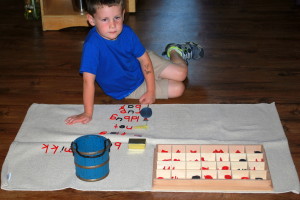There is growing talk about the value and need of movement in schools. Bloggers write about it and research shows the relationship between movement and brain development.
However, for conventional schools, they simply aren’t sure how to fit this in. More time outside? Regularly scheduled intervals for “movement”? Allow children to wander the classroom while the teacher is teaching? They are at a loss.
Such is the beauty of Dr. Maria Montessori’s background in medicine. Because she came to the work of education through a medical background, she was grounded in human biology and the needs of the developing human being. Of course children need to move freely in order to learn best – she essentially said. Dr. Montessori’s writings are full of thorough discussions of movement and its role in learning. Hands-on, manipulative activities for children form the basis for learning all day long in a Montessori environment. There are regular back and forth trips as the child retrieves pieces of an activity to be worked with, there is the actual reinforcement of a concept by having the child move as part of the lesson, and there is the freedom to move about the room in the pursuit of goals. For Dr. Montessori freedom of movement was not just a good idea it was central to learning.
The role of movement in Montessori is also one of the reasons that children experience “flow” in their Montessori class. This phenomenon, characterized by intense concentration, loss of awareness of time, revitalization, and being fully engaged in the activity was identified by the psychologist Mihály Csíkszentmihályi. Csíkszentmihályi subsequently conducted research with Montessori programs and found that, indeed, the Montessori environment contained all of the necessary conditions for children to experience what he calls “optimal experience”.
It’s no wonder that the popularity of Montessori continues to grow: it meets children’s’ needs and interests and is fully supported by 21st century research.


